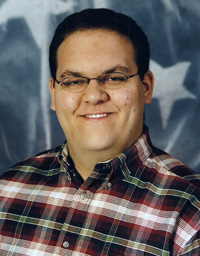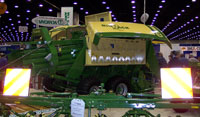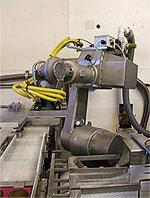 … but he thinks he can write!
… but he thinks he can write!
So Chuck couldn’t make me hot – It’s tough being a broadcaster sometimes – When the camera comes out, usually. In fact, my Dad called me when I got my first radio job and congratulated me on getting a position that really suited me. Looking for some more platitudes, I asked Dad what made him say sucha thing, to which he promptly replied, “You sure have a face for it.” I knew then that I would always have a strong fan base.
I’ve been in farm broadcasting my entire career, starting as a college intern with an early morning studio internship. I was in the office by 4:30 each morning to produce the morning show for our network’s farm broadcaster. I wasn’t on the air much, but I loved the work. While I was there, I was trained by a beautiful young producer whom I later married. To quote one of my fellow farm broadcasters from earlier this week, I really married up. Our network was purchased by a larger radio company at the end of my first year with the company, so I was out of radio and back into fulltime college at Ohio State. That didn’t last long – One of the sales consultants I had worked with at the network moved to a local radio station, WRFD-AM in Columbus. Along with being central Ohio’s strongest signal, WRFD was also Ohio’s only major farm radio station, producing over two hours of agricultural programming each day.
At WRFD I started in the sales arena, learning how to write effective selling messages and how to efficiently serve clients. These experiences were some of my most rewarding, because of the close relationship I built with so many of our sponsors. After a few weeks on the job, our station Program Director learned that I had previous studio experience, and promptly offered me more hours producing commercials and voicing small projects. I was thrilled to be back in the booth. The very next summer, I got my big break: broadcasting from county fairs! Because our sales team had successfully marketed over 35 county fairs across our state, there were more events to broadcast from than there were broadcasters to cover them. That meant I, junior farm broadcaster intern boy, got to head out on the road. Those early broadcasts were rough, but really fun. After a few of those, our afternoon drive talk show host Bob Burney invited me to fill in for him during the state fair – WOW! I was doing cartwheels in the aisles. Hosting a two hour talk show live from the Ohio State Fair was daunting enough, but filling in for our most popular host and previewing our Sale of Champions was enormous. I couldn’t belive my good fortune.
That broadcast is still one of my favorite memories on the radio. I had a great time, wonderful guests, and earned a great deal of respect from listeners and sponsors, as well as station management. Two months later, I was having breakfast with our General Manager. This breakfast started out innocently enough – he picked my brain about how we could improve our programming and marketing. By the time I finished my eggs, he had asked me to take over the Farm Department altogether. I was floored, thrilled, astonished, and blessed all at the same time. I served as host of our farm programming from 2002 through late 2005, and had the time of my life doing it. And then, it all came to an end.
The first Friday of the Ohio State Fair that year was a busy day. My wife was working with me at WRFD by that time, and we were doing everything in the farm department – broadcasting, sales, promotions, marketing, public relations, housekeeping, production, feeding the hogs (just kidding about that last part)… State Fair is one of our busiest times of the year with live broadcasts, shows, and countless stories to cover. So I was naturally a little miffed when the boss called me and told me to get back to the office right away. Assuming something bad was going to happen, I really had no idea what was going on.
Our parent company had decided that farm programming no longer had a place on our hallowed airwaves. After 58 years of providing the best farm radio programming in the state, RFD was no longer going to stand for Rural Free Delivery. While my wife and I were both offered other positions at the station, we both knew that farm broadcasting was our passion and our mission. And so after about three minutes and 37 seconds of discussion, we decided to strike out on our own – We’d be entreprenuers!
October 1st, 2005 I officially became CEO of AdVance Broadcast & Communication, Ltd. and I reported to our Chairman of the board (she’s the wife I mentioned eariler). On November 14th, we launched our broadcast, hailing The Buckeye Ag Radio Network as the Next Generation of Rural Radio accross three great radio stations. Now, nearly four months later, we have grown our listening area to include 11 radio stations in Ohio and Indiana, reaching over 55 counties and thousands of farmers. Our website is one of the premier agricultural news sources in the known universe (I can say that because my wife does 100% of the work) and we have just launched our own blogs and podcasts. You’re more than welcome to join us there.
I’m honored that Chuck and Cindy have asked me to join their stable of contributors, and I am anxiously awaiting your feedback on my thoughts and my stories. I have a great deal of passion for farm news, farm people, and in particular, the cattle industry. I grew up raising beef cows, but have always had a special affinity for the dairy industry. My Dad and his four siblings grew up milking cows, as did my Mother and her three brothers and sisters, so it’s in my blood, even if perhaps the genes ended up being recessive this generation. If you want to learn more about me, read my personal blog, Andy’s Angle. Feel free to email me any information requests or story ideas you come across. Most importantly, God speed and God bless.
 Select Sires of Plain City, Ohio has strengthened its stud with the addition of three top Jersey and one leading Milking Shorthorn bull to its sire string. The Jersey bulls are all graduates of Select’s Program for Genetic Advancement young sire program. The Milking Shorthorn Sire is the Number One bull in the breed according to Jeff Ziegler, manager of protein/specialty sire programs for Select Sires.
Select Sires of Plain City, Ohio has strengthened its stud with the addition of three top Jersey and one leading Milking Shorthorn bull to its sire string. The Jersey bulls are all graduates of Select’s Program for Genetic Advancement young sire program. The Milking Shorthorn Sire is the Number One bull in the breed according to Jeff Ziegler, manager of protein/specialty sire programs for Select Sires.
 … but he thinks he can write!
… but he thinks he can write! Let me officially introduce you to Andy Vance,
Let me officially introduce you to Andy Vance, 
 Boy, talk about a name problem. An
Boy, talk about a name problem. An  At the recent Farm Machinery Show in Louisville, KY, Andy Vance of
At the recent Farm Machinery Show in Louisville, KY, Andy Vance of 
 From Mr.
From Mr.  One of the sponsors of World Dairy Diary is
One of the sponsors of World Dairy Diary is  When I think of robots I usually think of something like what Will Smith ran into on
When I think of robots I usually think of something like what Will Smith ran into on